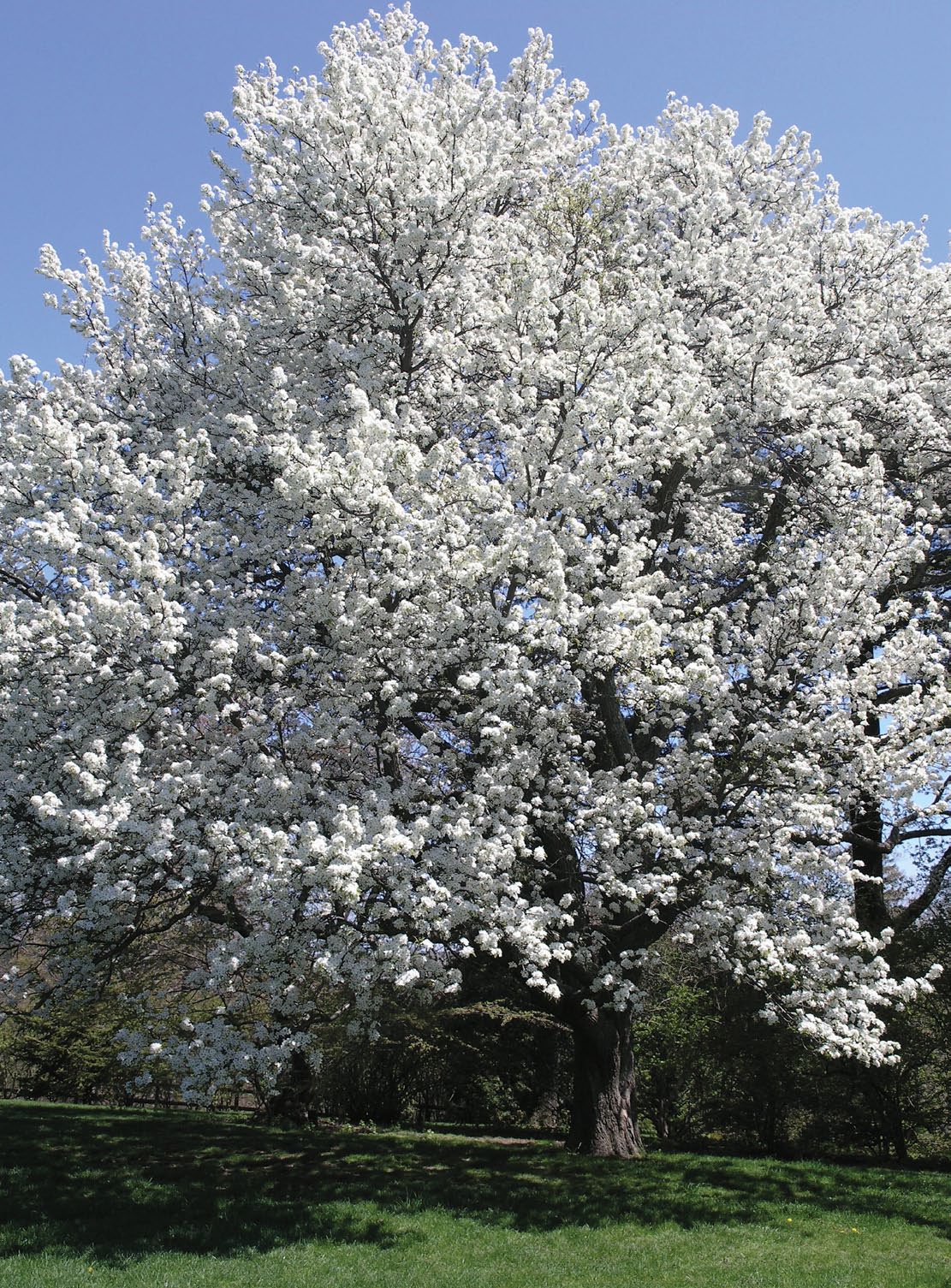In more than thirty years at the Arnold Arboretum, I have observed many trees in our collections. Some have not lived up to expectations, but others have proven themselves over time. One such tree is the specimen of sand pear (Pyrus pyrifolia, accession 7272-C) growing at the back edge of the open meadow below the summit of Bussey Hill, which I consider to be the most beautiful flowering tree in the Arboretum.

This tree comes into flower in late April or early May, depending on the weather, and at its peak bloom it shines like a beacon in the early spring landscape. When first glimpsed from Bussey Hill Road, against a backdrop of tall white pines, it looks like a giant white cloud—an effect that is intensified because no leaves compete with the floral display. The flowers are pure white with crimson anthers, 3 to 3.5 centimeters (1.2 to 1.4 inches) in diameter, and are borne in rounded clusters on slender stalks. In bloom, the tree can be easily spotted from the top of Peters Hill, some 800 meters (2,600 feet) away as the crow flies. It stays in flower for up to a full week, holding up well through all kinds of inclement early spring weather.
In fall, the tree’s glossy, dark green leaves turn beautiful shades of orange and red. Its hard, round fruits are 3 to 4 centimeters (1.2 to 1.6 inches) in diameter, brown, and covered with pale dots. The fruit has an extremely gritty texture (hence its common name—sand pear) and a puckery aftertaste when bitten into. It’s hard to imagine how the delectable Chinese and Japanese “apple-pears” in the supermarket were derived from this astringent ancestor.
The magnificent sand pear on Bussey Hill stands 16.9 meters (55.4 feet) tall with a spread of 25.7 meters (84.3 feet) and a trunk DBH (diameter at breast height) of 79 centimeters (31.1 inches). Remarkably, it seems never to have suffered any major snow, ice, or wind damage—an unexpected observation given its age (101 years) and the exposure of the site where it is growing. Such structural integrity provides a striking contrast to the widely planted but notoriously weak ‘Bradford’ Callery pear (Pyrus calleryana ‘Bradford’), which shows an all too predictable tendency to split apart in severe storms after about age 20. Were it not for its relatively large, messy fruits, our streets might well have been planted with sand pears instead of Callery pears.
The Arboretum’s beacon tree was grown from seed collected by E. H. Wilson in the fall of 1907, somewhere in the mountains surrounding the city of Ichang in Hupeh (now Hubei) Province. When Wilson collected the seed he did not give the tree a species name, but noted that the Chinese called it “tang li tzu.” At the time, sand pears were classified as Pyrus sinensis, a name which was used mainly to describe cultivated plants with large, edible fruits. Back at the Arboretum, Alfred Rehder decided that Wilson’s tree was the wild ancestor of these cultivated trees and, in 1915, proposed the name Pyrus serotina for Wilson’s specimens. Taxonomy is ever changeable, though, and in 1926 the Japanese botanist Nakai reduced Rehder’s name to synonymy with Pyrus pyrifolia—the name the species now bears.
Citation: Del Tredici, P. 2010. The sand pear—Pyrus pyrifolia. Arnoldia, 67(4): 28–29.
Wilson’s sand pear seeds arrived at the Arboretum in April 1908 and germinated in the spring of 1909. Sometime prior to 1918, at least three of the seedlings were planted on the grounds. Remarkably, all three are still alive today—a testament to the toughness and tenacity of the species. Specimen 7272-C is the finest of the three, and it will, I hope, remain a shining spring beacon for Arboretum visitors for many years to come.
Peter Del Tredici is a Senior Research Scientist at the Arnold Arboretum.